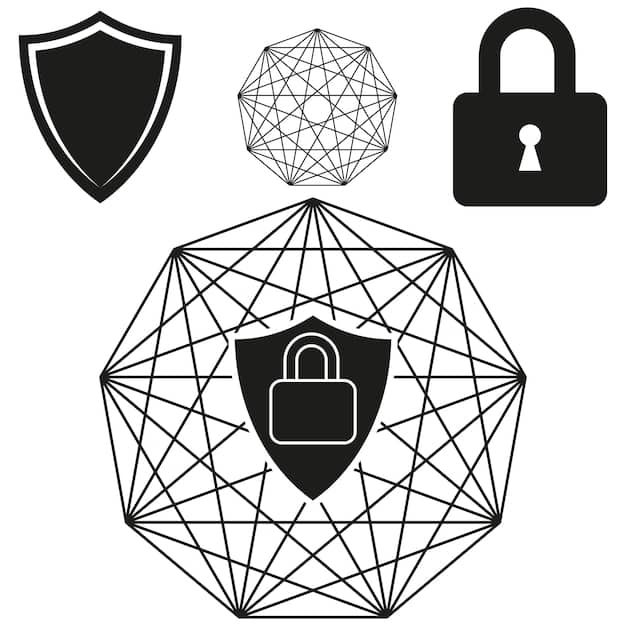New US Cybersecurity Regulations: A 2026 Compliance Guide for Businesses

The new US Federal Cybersecurity Regulations, effective by January 2026, require businesses to implement enhanced security measures, including risk assessments, data encryption, incident response plans, and employee training to protect sensitive information and infrastructure from evolving cyber threats.
Navigating the evolving landscape of cybersecurity regulations can be daunting, especially for businesses operating in the US. With the clock ticking towards January 2026, understanding and implementing the new US Federal Cybersecurity Regulations is not just a matter of compliance, but a critical step in safeguarding your organization’s assets and reputation.
Understanding the Scope of New US Federal Cybersecurity Regulations
The new regulations are designed to address the growing cybersecurity threats facing businesses across various sectors. These regulations aim to establish a baseline of security standards and practices that all organizations must adhere to.
These enhance the earlier directives which were not as detailed or broad.
Key Areas Covered by the Regulations
The regulations cover a wide range of areas, including data protection, incident response, and risk management. Understanding these key areas is crucial for compliance.
- Data Encryption: Protecting sensitive data both in transit and at rest.
- Incident Response Planning: Developing a plan to address and mitigate cybersecurity incidents.
- Risk Assessments: Regularly assessing cybersecurity risks and implementing appropriate security measures.
- Employee Training: Educating employees about cybersecurity threats and best practices.
Businesses must proactively identify potential security gaps to mitigate risks and remain compliant with the new requirements.

The impact from these regulations spans many sectors.
Sector-Specific Cybersecurity Requirements
While the new regulations provide a general framework, certain sectors may have additional specific requirements. These sector-specific considerations reflect the unique risks and challenges faced by different industries.
For example, this may involve critical infrastructure or sensitive financial data.
Healthcare
Healthcare organizations must comply with HIPAA and other regulations to protect patient data and ensure the confidentiality of medical records.
Finance
Financial institutions face stringent cybersecurity requirements due to the sensitive nature of financial data and the potential for fraud and theft.
Critical Infrastructure
Entities involved in critical infrastructure, such as energy and transportation, must adhere to specific cybersecurity standards to protect vital services and prevent disruptions.
A breach in any of these sectors can affect the national stability.
Implementing a Cybersecurity Framework
A robust cybersecurity framework is essential for compliance with the new regulations. This framework should include policies, procedures, and technologies to protect against cyber threats.
The new regulations build on existing frameworks, adding new layers based on recent attacks. It is crucial to stay relevant.
NIST Cybersecurity Framework
The NIST Cybersecurity Framework provides a comprehensive approach to managing cybersecurity risks. It includes five core functions: Identify, Protect, Detect, Respond, and Recover.
ISO 27001
ISO 27001 is an international standard for information security management systems. It provides a framework for establishing, implementing, maintaining, and continually improving an information security management system (ISMS).
CIS Controls
The CIS Controls are a set of prioritized security actions that organizations can take to protect their systems and data from cyberattacks.
- Inventory and Control of Hardware Assets: Identifying and managing all hardware devices on the network.
- Inventory and Control of Software Assets: Managing and monitoring all software applications on the network.
- Continuous Vulnerability Management: Regularly scanning for and addressing vulnerabilities in systems and applications.
- Controlled Use of Administrative Privileges: Limiting and monitoring the use of administrative privileges to prevent unauthorized access.
Having an effective incident response plan is important.
Developing an Incident Response Plan
An incident response plan outlines the steps to take in the event of a cybersecurity incident. This plan should be well-documented and regularly tested to ensure its effectiveness.
Without a plan, your data can be compromised for several days.
Key Components of an Incident Response Plan
An effective incident response plan should include the following components:
- Identification: Detecting and identifying cybersecurity incidents.
- Containment: Isolating and containing the incident to prevent further damage.
- Eradication: Removing the threat and restoring affected systems.
- Recovery: Recovering data and systems and returning to normal operations.
- Lessons Learned: Analyzing the incident and identifying areas for improvement.
An efficient incident response plan helps minimize damage and speed recovery.

Staying up-to-date and compliant requires proactive cybersecurity practices.
Proactive Cybersecurity Practices for 2026
In addition to implementing a cybersecurity framework and developing an incident response plan, businesses should adopt proactive cybersecurity practices to stay ahead of emerging threats.
This can involve internal and external security measures.
Regular Security Audits
Conducting regular security audits helps identify vulnerabilities and assess the effectiveness of security measures. These audits should be performed by qualified professionals.
Penetration Testing
Penetration testing involves simulating cyberattacks to identify weaknesses in systems and applications. This helps organizations understand their vulnerabilities and improve their defenses.
Threat Intelligence
Staying informed about the latest cyber threats and vulnerabilities is crucial for maintaining a strong security posture. Subscribing to threat intelligence feeds and participating in industry forums can help businesses stay ahead of emerging threats.
- Vulnerability Scanning: Use automated tools to scan systems for known vulnerabilities.
- Security Awareness Training: Provide ongoing training to employees to educate them about cybersecurity threats and best practices.
- Multi-Factor Authentication: Implement multi-factor authentication to protect against unauthorized access to systems and data.
Cybersecurity training goes a long way.
The Importance of Cybersecurity Training
Human error is a significant factor in many cybersecurity breaches. Providing comprehensive cybersecurity training to employees can help reduce the risk of human error and improve overall security.
It should be viewed as an investment to protect your business.
Topics to Cover in Cybersecurity Training
Cybersecurity training should cover a range of topics, including:
- Phishing Awareness: Identifying and avoiding phishing scams.
- Password Security: Creating strong passwords and avoiding password reuse.
- Social Engineering: Recognizing and avoiding social engineering attacks.
- Data Protection: Understanding and complying with data protection policies.
By focusing on the above key things you can mitigate the risk and reach compliance.
Preparing for the 2026 Deadline
With the January 2026 deadline approaching, businesses must take immediate steps to prepare for the new US Federal Cybersecurity Regulations. This includes assessing their current security posture, developing a compliance plan, and implementing the necessary security measures.
Begin implementing the changes now.
Steps to Take Now
- Assess Your Current Security Posture: Identify gaps in your security measures and prioritize areas for improvement.
- Develop a Compliance Plan: Create a detailed plan outlining the steps to achieve compliance with the new regulations.
- Implement Security Measures: Implement the necessary security measures, such as data encryption, incident response planning, and employee training.
- Monitor and Review: Continuously monitor and review your security measures to ensure their effectiveness and compliance with the regulations.
Meeting the upcoming deadline requires a focused approach.
| Key Area | Brief Description |
|---|---|
| 🛡️ Data Encryption | Protecting sensitive data both during transfer and storage. |
| 🚨 Incident Response | Creating a plan for addressing and mitigating cybersecurity incidents. |
| 🔍 Risk Assessments | Regularly assessing cybersecurity risks and implementing measures. |
| 👨🏫 Employee Training | Educating employees on cybersecurity and best practices. |
FAQ
▼
The primary goals include enhancing data security, improving incident response capabilities, and establishing a baseline for security practices across all sectors. This is necessary to improve national security.
▼
Security audits should be conducted regularly, ideally at least once a year, or more frequently if your business handles a large volume of sensitive data or has a high-risk profile. Review your business profile.
▼
Your plan should include steps for identifying, containing, eradicating, and recovering from cybersecurity incidents, as well as a process for documenting lessons learned from each event to improve future responses.
▼
Cybersecurity training should cover phishing awareness, password security, social engineering, and data protection policies, ensuring all employees understand their role in maintaining the organization’s security posture.
▼
Risk can be evaluated by considering the impact of each possible threat. You can conduct regular checks or consult sector-specific frameworks to meet the evolving regulatory needs.
Conclusion
As the January 2026 deadline approaches, businesses must prioritize compliance with the new US Federal Cybersecurity Regulations. By understanding the scope of the regulations, implementing a robust cybersecurity framework, developing an incident response plan, adopting proactive cybersecurity practices, and investing in employee training, organizations can protect themselves from cyber threats and ensure compliance.





